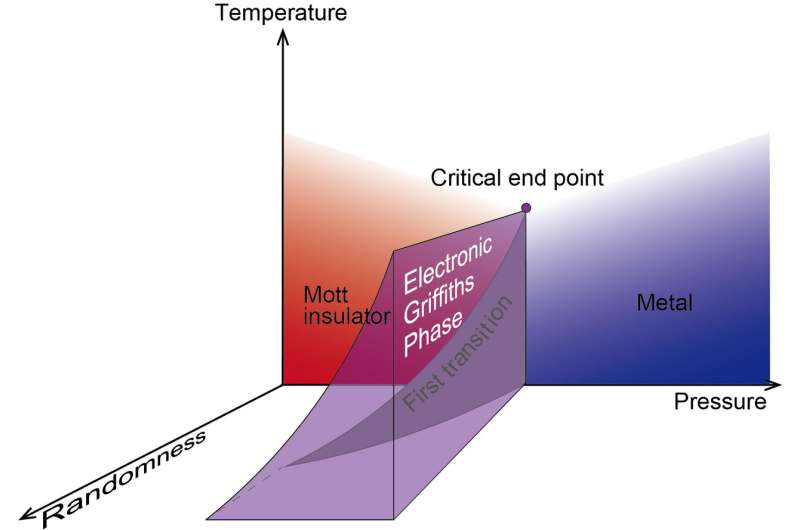Schematic temperature-pressure-randomness phase diagram of the Mott transition system examined by the researchers. The electrons in the electronic Griffiths phase behave like soft matter. Credit: Yamamoto et al.
Most theories of solid state and soft matter physics were developed independently; thus, a few physical concepts are applicable to both. Recent research, however, particularly a study by Elbio Dagotto, found that correlated electrons in solid-state physical systems can sometimes present a spatially inhomogeneous phase accompanied by extraordinarily slow electron dynamics, which resembles a phase observed in soft-matter systems.
"This phenomenon causes interesting effects, such as colossal magnetoresistance, and it also appears crucial to understand the high-temperature superconductors," Dagotto wrote in his paper. "The spontaneous emergence of electronic nanometer-scale structures in transition metal oxides, and the existence of many competing states, are properties often associated with complex matter where nonlinearities dominate, such as soft materials and biological systems."
Researchers at Tokyo University of Science, the University of Tokyo and Tohoku University have recently tried to better understand the conditions that can enable this unusual behavior in solid matter systems. Their paper, published in Physical Review Letters, demonstrates that when certain conditions are met, the electrons in an organic Mott-transition system fluctuate very slowly, which could be explained by the occurrence of what they refer to as the "electronic Griffiths phase."
"As Dagotto emphasized, the soft-matter behavior in correlated electrons is very likely to be responsible for colossal responses (e.g. colossal magnetoresistance) and to be related to the high-Tc physics," Riku Yamamoto, one of the researchers who carried out the study, told Phys.org. "In spite of its importance, however, very few systematic experimental studies have been undertaken to investigate the mechanism why correlated electrons show the soft-matter behavior in solid matter."
Yamamoto and his colleagues observed the behavior of electrons in a Mott-transition system using nuclear magnetic resonance (NMR), which is currently one of the most effective methods to detect extremely slow electron dynamics. Their experiments allowed them to identify the conditions under which correlated electrons in the system present extremely slow dynamics, which are a common characteristic of soft matter.
"We demonstrated that the soft-matter behavior (extremely-slow electron dynamics) is realized only when the following two factors are met simultaneously: i) the electronic system is just on the metal/Mott-insulator boundary and ii) the system is subject to quenched disorder," Yamamoto explained. "This finding strongly suggests that the soft-matter behavior is explained by the concept of 'electronic Griffiths phase.'"
The recent study carried out by Yamamoto and his colleagues sheds some light on the dynamics behind the soft matter-like behavior that Dagotto and other physicists previously observed in solid matter systems. It also offers valuable insight about the physics of highly-correlated electron systems, such as high-Tc cuprates and CMR manganites.
The researchers explained the soft matter-like behavior of electrons in the Mott-transition system they examined by suggesting that it is undergoing what is known as the 'electronic Griffiths phase." In the future, their work could encourage more studies merging solid state and soft matter physics, two research areas that are often considered in isolation.
"The electronic Griffiths scenario may be a key concept for understanding the slow dynamics sometimes observed in correlated electron systems," Yamamoto said. "Although what we demonstrated in this work is that this scenario is realized in a certain organic system, we believe that this concept can be applied to a large variety of correlated-electron materials such as cuprates and manganites. We would like to demonstrate it in the future."
More information: Riku Yamamoto et al. Electronic Griffiths Phase in Disordered Mott-Transition Systems, Physical Review Letters (2020). DOI: 10.1103/PhysRevLett.124.046404
E. Dagotto. Complexity in Strongly Correlated Electronic Systems, Science (2005). DOI: 10.1126/science.1107559
Journal information: Physical Review Letters , Science
© 2020 Science X Network
























